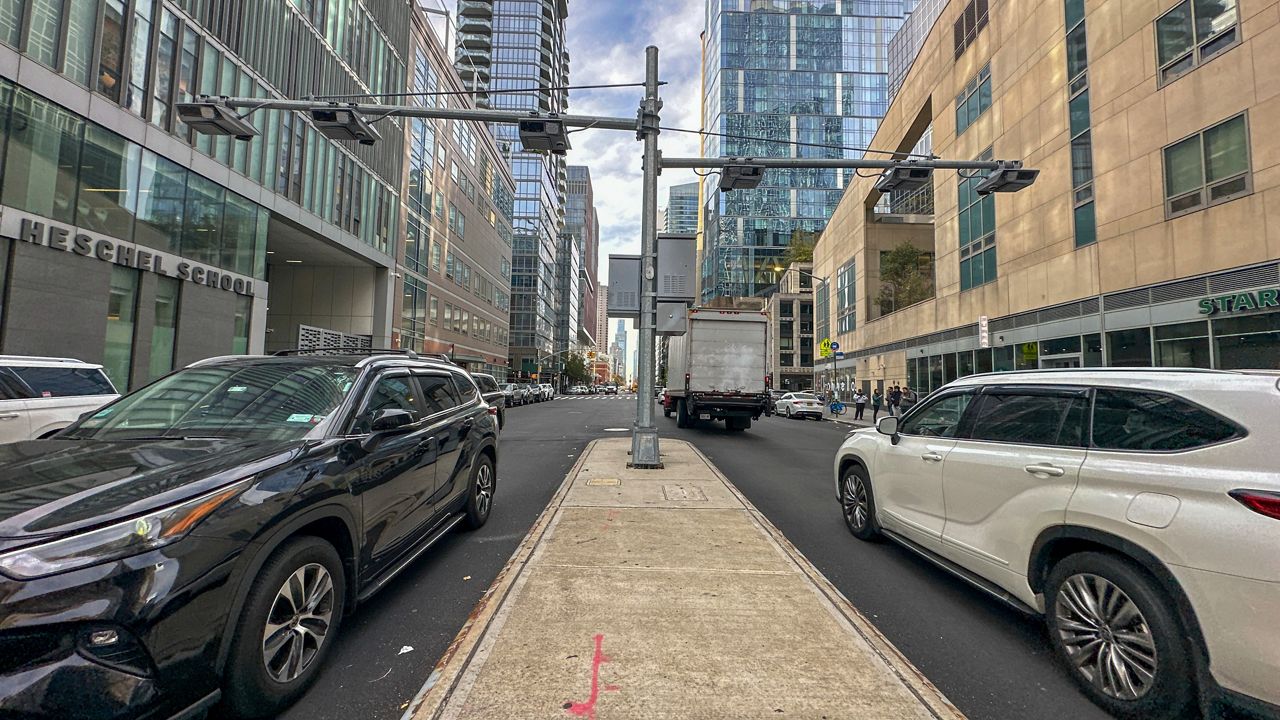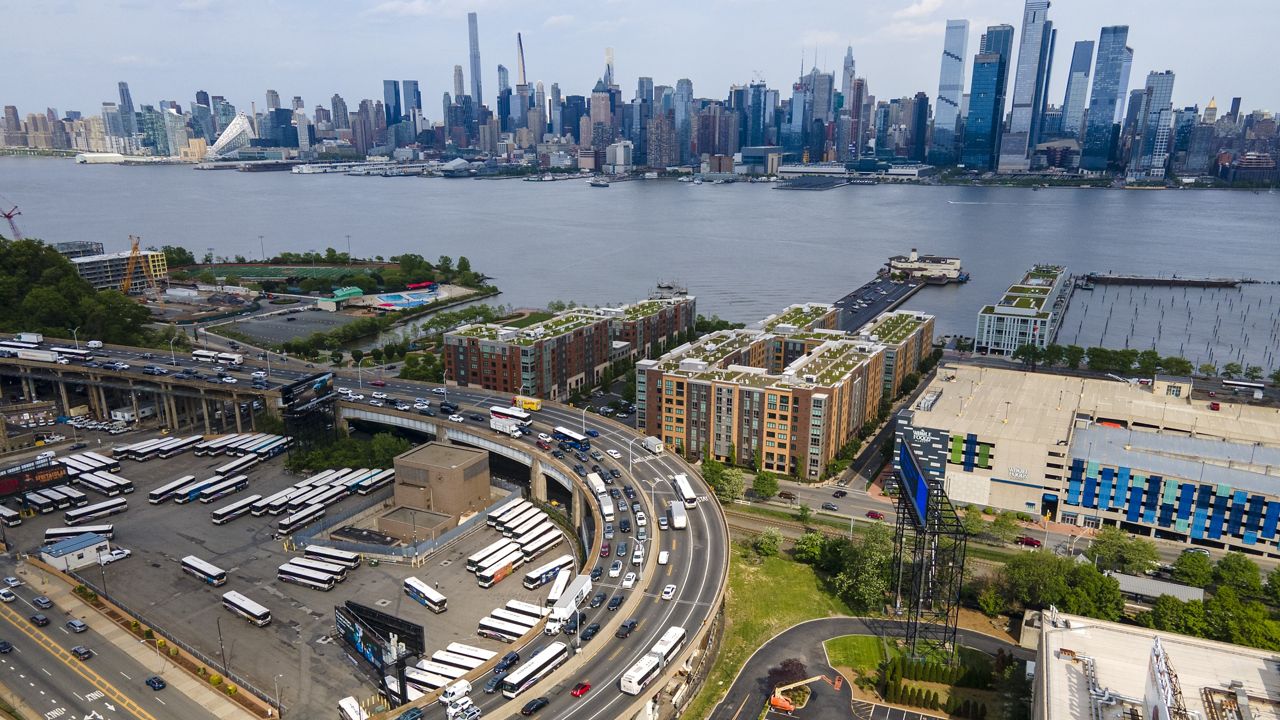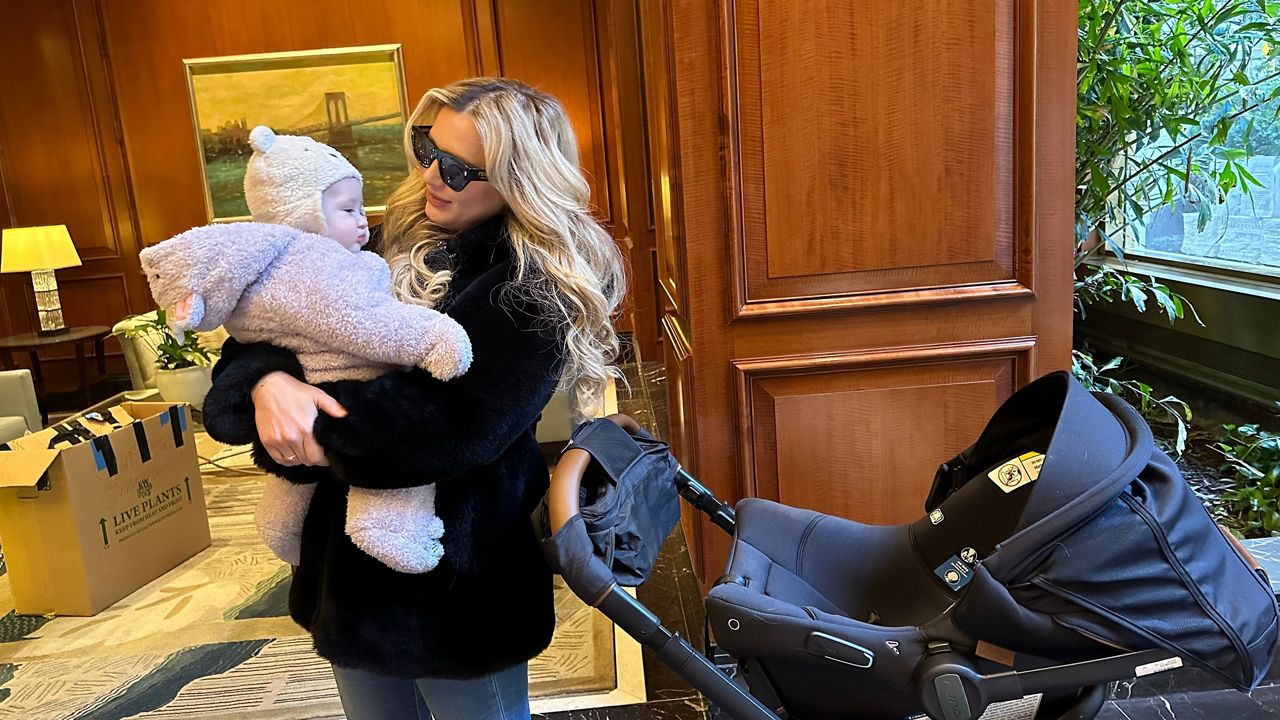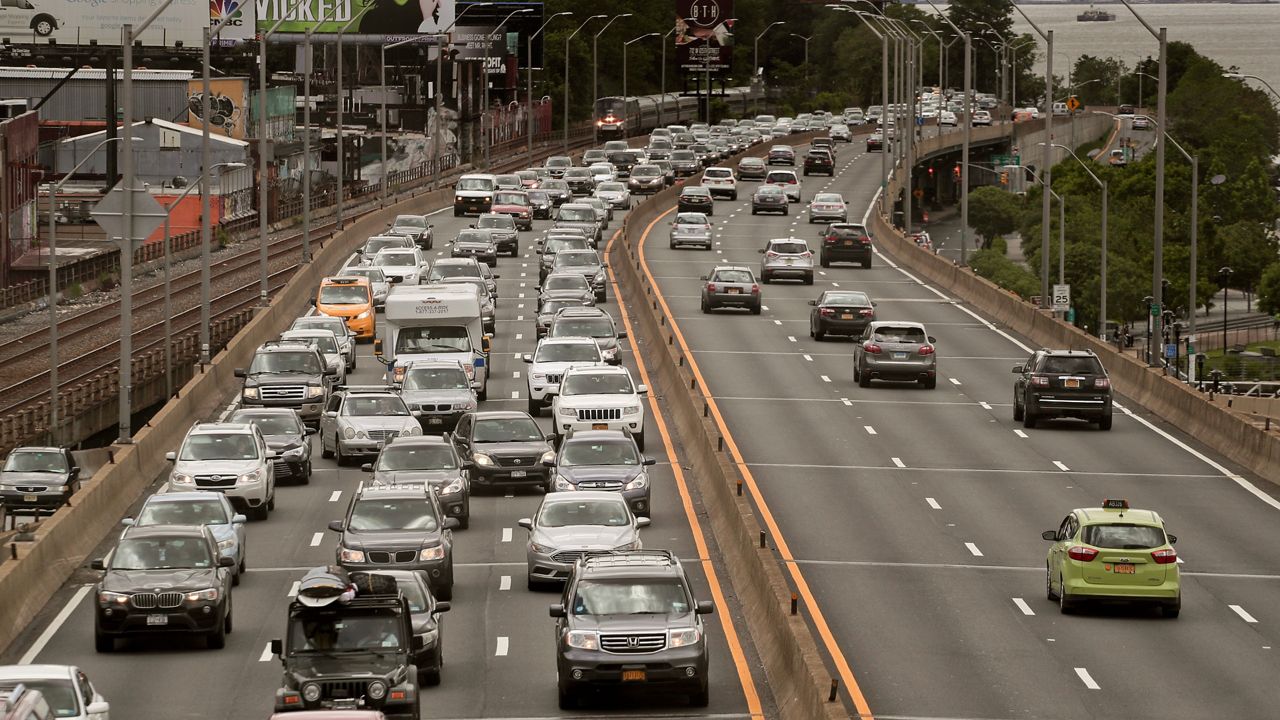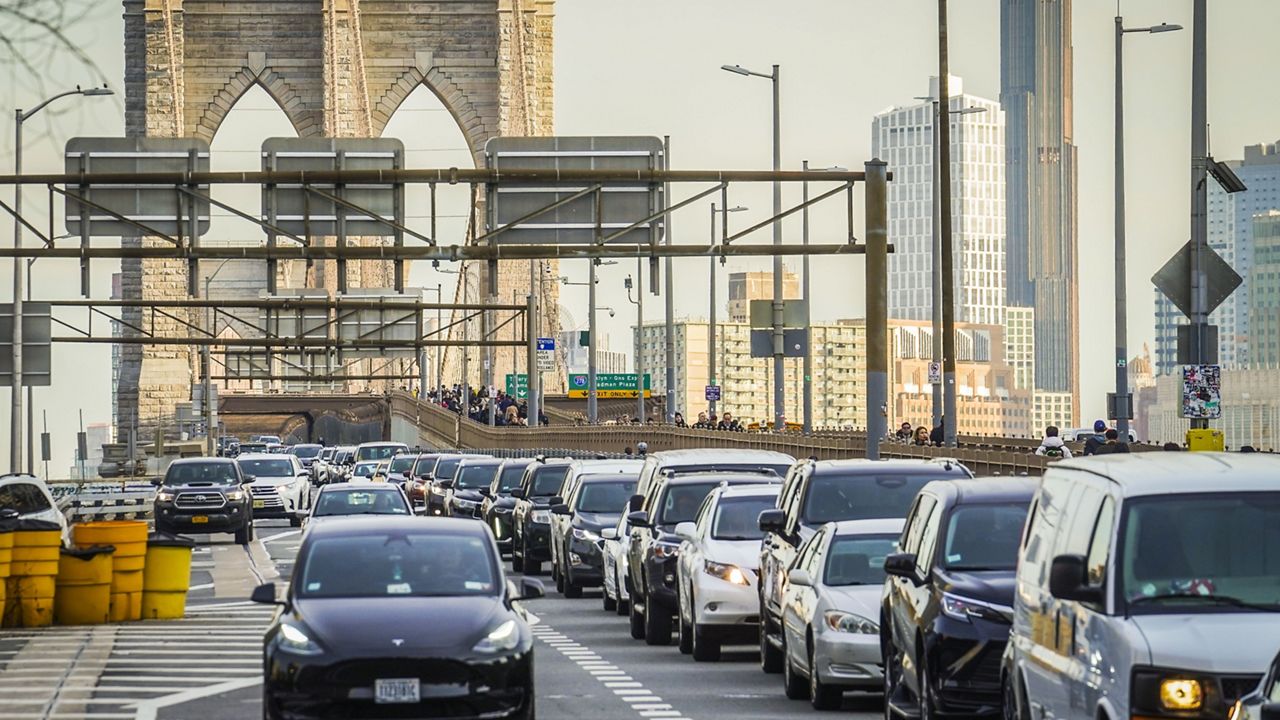Congestion pricing is now in effect in New York City.
The congestion pricing plan imposes a $9 base fare for cars with E-ZPass tags entering Manhattan south of 60th Street. Exemptions have already been laid out and tolling mechanisms are in place, but questions still remain.
NY1 will answer as many questions as possible and keep this file updated. Answers are based on information provided by the MTA.
Meanwhile, see our congestion pricing explainer here, and check out what you need to know about E-ZPass tolling here.
Question: Who is exempt from congestion pricing? How do I apply for an exemption?
The initial plan from the Traffic Mobility Review Board noted some discounts. Those discounts were reduced by 40% as part of the revised plan. They include:
- A 50% discount for low-income drivers after the first 10 trips in one calendar month.
- Cars will be charged $9 from 5 a.m. to 9 p.m. on weekdays and 9 a.m. to 9 p.m. on weekends. That will go down to $2.25 overnight.
- Small trucks will pay $14.40 and large trucks will pay $21.60. Both will get a 75% discount overnight.
- Yellow taxis avoid the toll, instead passing a 75-cent fare charge onto their passengers. For-hire vehicles like Uber and Lyft will charge passengers an extra $1.50 a ride.
- Some private buses that run regular schedules like Megabus and Hampton Jitney, and some school buses, will be exempt from the toll.
Additionally, the MTA announced two exemption plans in late February for New Yorkers with disabilities. The first plan is called the Individual Disability Exemption Plan and enables people with disabilities to register their own vehicle, or designate another, for toll exemption. The second plan is called the Organizational Disability Exemption Plan, and exempts registered public and private organizations transporting people with disabilities. Residents and business an apply for discounts and exemptions via the MTA's website.
Question: How will the toll be phased in?
The MTA will gradually implement the toll structure approved by the MTA Board in March 2024. At midnight on Jan. 5, 2025, tolls began at 60% of their full $15 value. In 2028, tolls will increase to 80% of their full value, and by 2031, they will reach 100%.
This means non-commercial vehicles entering the congestion pricing zone will pay $9 during peak hours and $2.25 overnight. In 2028, rates will increase to $12 during peak hours and $3 overnight. In 2031, passenger vehicles will pay $15 during peak hours and $3.75 overnight. The percentage increases will apply to all vehicle toll rates.
Question: Will I be charged to move around inside the congestion pricing zone?
Drivers who begin their trip inside the congestion pricing zone will not be charged a toll if their trip remains entirely inside the zone. For example, if you entered on Monday — incurring a fee — and parked within the zone until Tuesday, driving around below 60th Street on Tuesday won't cost you. A toll is levied once a day between midnight to 11:59 p.m., even if you drive in and out of the zone within those 24 hours.
But if you entered on Monday — incurring a fee — and parked within the zone until Tuesday, then exited and reentered the zone, you will be charged upon reentry.
Question: If I use the West Side Highway or FDR Drive and exit in the congestion pricing zone — even if briefly or to park — will I be tolled?
While the West Side Highway and FDR Drive are exempt from congestion pricing, if you exit to local streets and avenues south of 60th Street, you will be charged a toll.
Question: How will I be charged when I exit into the congestion pricing zone via the West Side Highway or FDR Drive? Will I be charged if I don't exit the West Side Highway or FDR Drive?
The MTA monitors vehicle movement via cameras across Manhattan, including within the congestion pricing zone.
While you may not cross a tolling checkpoint during your commute, if your vehicle is detected driving south past 60th Street and then entering a local street — even if utilizing a parking lot adjacent to either exempt roadway — a congestion pricing toll will be applied.
If you are detected driving just between the West Side Highway and FDR Drive, or if you are detected accessing the Hugh L. Carey Tunnel (Brooklyn-Battery Tunnel) via the West Side Highway, you will not incur a toll.
Question: How will a vehicle with an out-of-state E-ZPass be charged to enter Manhattan? Do I need to have an E-ZPass New York account?
Motorists using any state's E-ZPass would be charged at the E-ZPass rate. However, in order to participate in a discount or exemption plan, drivers will need an E-ZPass New York account.
Question: How soon will the toll appear on my E-ZPass account?
For E-ZPass customers, toll charges will typically appear on their account within two days, according to the MTA. Tolls by Mail customers will be charged when an invoice is sent to the address associated with their vehicle's registration.
The MTA does warn that there may be delays as billing systems are adjusted during the initial rollout.
Question: What will congestion pricing be on holidays?
There are no special holiday rates under congestion pricing. If a holiday falls on a weekday, drivers will be charged the usual weekday fees. If a holiday falls on a weekend, drivers will be charged the usual weekend fees.
Question: Are drivers charged if they are going into Battery Park City?
Yes, the congestion pricing zone encompasses all of Manhattan south of 60th Street, excluding the FDR Drive, West Side Highway and the connecting roadways to the Hugh L. Carey Tunnel (Brooklyn-Battery Tunnel).
Question: How will motorcycles be charged under congestion pricing?
The toll for motorcycles with E-ZPass tags is $4.50 during peak hours and $1.12 during off-peak hours. It remain unclear what motorcycles without E-ZPass would be charged, though the MTA has said E-ZPass rates are generally 50% lower than Toll by Mail rates. Like passenger vehicles, motorcycles are only charged once per day.
Question: If you start your trip in the congestion zone and use the FDR Drive or West Side Highway to then re-enter local streets within the congestion zone, is there a charge?
No charge applies for this route. Motorists who begin their travels within the zone will not be charged a congestion pricing fee. This includes travel on the FDR Drive and West Side Highway. However, if you leave and re-enter the congestion pricing zone, you will be charged a toll.
Question: Will I be charged more than once if I drive in and out of the congestion pricing zone multiple times in one day?
No. Passenger vehicles and motorcycles pay no more than once per day. The tolling period begins each day at midnight and continues through 11:59 p.m. Vehicles making multiple entries into the congestion pricing zone within this timeframe will be charged the toll that is in effect at the time they first enter the zone.
Question: I live in the congestion pricing zone. Do I still have to pay?
Yes, residents within the congestion pricing zone are subject to toll charges unless they qualify for an exemption.
Passenger vehicles and motorcycles will be charged when the vehicle enters the zone, but no charges will be incurred on days when the vehicle remains parked within the zone, or if the vehicle is traveling strictly within the congestion pricing zone.
Residents with a household adjusted gross income under $60,000 may be eligible for a tax credit. Find out more about exemptions and credits here.
Question: How will I be charged when I take the Ed Koch Queensboro Bridge (59th Street Bridge)?
All vehicles accessing the Ed Koch Queensboro Bridge — also known as the 59th Street Bridge — including via the FDR Drive, will be charged a toll, except for those using the upper level of the bridge to travel from Queens to the Upper East Side, as that ramp exits onto 62nd Street.
Because both the Manhattan entrances — the lower and upper levels — are below 60th Street, all vehicles utilizing the bridge to leave Manhattan will be charged a toll. There are no routes using the bridge to leave Manhattan that avoid the congestion pricing zone.




